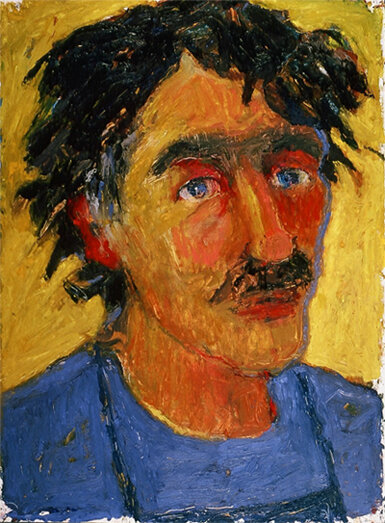Ask Richard: Drying Times for Pigment Sticks
Ask Richard is back! We chatted with R&F founder Richard Frumess about the burning question seemingly on everyone’s mind - Pigment Stick® drying times.
Portrait of R&F founder Richard Frumess in Pigment Sticks by Dorothy Wiegner in 1994.
Probably the number one question we get from folks who work with R&F Pigment Sticks® concerns their drying time. What can you tell us about that?
Let’s start with the science. R&F Pigment Sticks® are made with linseed oil, wax, and powdered pigment, but they dry as oil paint dries - which is to say, they oxidize. The oxygenated linseed oil forms long chains through a process called polymerization and becomes an irreversible dry film that is not soluble. It is now a new chemical called “linoxyn.”
There are multiple factors that affect this drying process, which is referred to as “curing.”
What are some of those factors?
Light is a factor. Drying in ambient light helps to speed up the drying time.
Temperature is also a factor. Paintings in warmer temperatures dry faster than those in cold temperatures.
Humidity plays a role. Low humidity will allow your paintings to dry faster than high humidity.
The substrate affects drying time. An absorbent substrate (such as Ampersand Encausticbord or Ampersand Gessobord) will enable your painting to dry faster, as it will soak up some of the oil.
Application impacts drying time as well. A thick layer will take longer to dry than a thin layer of Pigment Stick®.
Blue Ochre Pigment Stick®
And then, there’s the pigment itself. Some pigments grab oxygen faster than others. For example, our Raw Umber Pigment Stick® dries relatively fast because it contains manganese, which acts as a catalyst. Cobalt is also a faster drier. Cadmium is slower.
How can artists tell whether a particular Pigment Stick® dries slower or faster?
We categorize our Pigment Sticks® in terms of their drying speed as Very Slow, Slow, Medium, and Fast. You can find an index on the back of our Color Chart that shows you how each of our colors is categorized. Download an R&F Color Chart here.
What about R&F Blending Medium with Drier? How is that different from R&F’s regular Blending Medium?
We describe our Blending Medium as “a Pigment Stick without pigment.” It’s ideal for glazing colors. It can be worked directly into a color to increase the color’s transparency or used to blend colors together a surface.
Blending Medium with Drier is a version of our Blending Medium that contains a small amount of cobalt and manganese drier to help speed up drying times. The use of a drier can affect color, so the best use is to work colors on top of it after it has been laid down on the surface.
Blending Medium with or without drier comes in both a stick form (38ml., 100ml., and 188ml.) and in jars (8oz., 16oz., and 32oz.).
Want to see R&F Pigment Sticks® in action? Watch this meditative video of artist Charles Forsberg painting with R&F Pigment Sticks in Berlin in 2015.
Curious about working with Blending Medium? Check out our YouTube demo video.
Got a burning question for Richard? Send it here.



